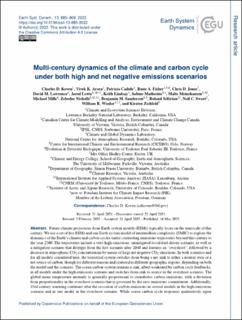| dc.description.abstract | Future climate projections from Earth system models (ESMs) typically focus on the timescale of this century. We use a set of five ESMs and one Earth system model of intermediate complexity (EMIC) to explore the dynamics of the Earth's climate and carbon cycles under contrasting emissions trajectories beyond this century to the year 2300. The trajectories include a very-high-emissions, unmitigated fossil-fuel-driven scenario, as well as a mitigation scenario that diverges from the first scenario after 2040 and features an “overshoot”, followed by a decrease in atmospheric CO2 concentrations by means of large net negative CO2 emissions. In both scenarios and for all models considered here, the terrestrial system switches from being a net sink to either a neutral state or a net source of carbon, though for different reasons and centered in different geographic regions, depending on both the model and the scenario. The ocean carbon system remains a sink, albeit weakened by carbon cycle feedbacks, in all models under the high-emissions scenario and switches from sink to source in the overshoot scenario. The global mean temperature anomaly is generally proportional to cumulative carbon emissions, with a deviation from proportionality in the overshoot scenario that is governed by the zero emissions commitment. Additionally, 23rd century warming continues after the cessation of carbon emissions in several models in the high-emissions scenario and in one model in the overshoot scenario. While ocean carbon cycle responses qualitatively agree in both globally integrated and zonal mean dynamics in both scenarios, the land models qualitatively disagree in zonal mean dynamics, in the relative roles of vegetation and soil in driving C fluxes, in the response of the sink to CO2, and in the timing of the sink–source transition, particularly in the high-emissions scenario. The lack of agreement among land models on the mechanisms and geographic patterns of carbon cycle feedbacks, alongside the potential for lagged physical climate dynamics to cause warming long after CO2 concentrations have stabilized, points to the possibility of surprises in the climate system beyond the 21st century time horizon, even under relatively mitigated global warming scenarios, which should be taken into consideration when setting global climate policy. | en_US |

